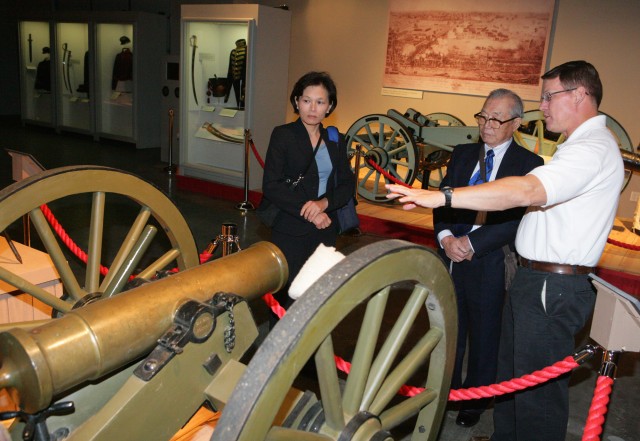
FORT SILL, Okla.-- When HyoWon Choi visited Fort Sill Sept. 27 it coincided with the date of his first visit.
This time Choi was aided by his daughter Bo, who drove a comfortable, foreign car onto post and then to the Field Artillery Museum. Previously, Choi and 100 Republic of Korea Army officers sailed into San Francisco then boarded a train for a three-day transcontinental trip arriving at Fort Sill for artillery training Sept. 27, 1951.
Though he spoke little English and relied heavily on his daughter to translate, the 84-year-old retired RoK army colonel spoke with firm conviction and emphasized many points about his experiences here.
"It's great to be back here, but it's also a shock to see how much has changed since I was stationed here," he said.
Fifty-nine years ago the Korean officers' need for artillery training was great as their country was warring against Korean communists aided by China and the Soviet Union.
"We learned how to direct artillery fire during our training here," he said. "It was immensely helpful to the South Korean people."
Although the RoK officers were here to learn, their arrival was immensely important to the thousands of U.S. Soldiers preparing to head to Korea for the fight. He said many Soldiers didn't know where the Korean peninsula was or what to expect when they got there.
"We gave Soldiers a lot of information about life in Korea and especially told them how cold it can get over there," he said.
During that first visit, Choi ventured off post into Lawton where he found a solace at the Beal Heights Presbyterian Church. Memories of it and the people who welcomed him, spurred him to visit again for morning and evening services Sept. 26. He noted the sanctuary furniture looked much the same as when he faithfully attended services there.
For Choi, returning to Fort Sill was a way for him to express his appreciation to the U.S. Army for coming to the need of his people during their time of need. He added today's Soldiers may likely come in contact with people in far off lands.
"The world is getting smaller and many Soldiers don't know where they are going or what they will be doing," he said. "Each of you may have opportunities to significantly impact the lives of others, so be proud of yourself and your service to your country."
As Gordon Blaker, museum curator, gave Choi a tour of the artifacts on display, Choi stopped at one exhibit and stood a little taller and prouder for he was standing before a picture of former president Harry Truman. Choi said Truman will always be his No. 1 U.S. president. With Democratic Peoples' Republic of Korea forces invading the South, Truman quickly foresaw the consequences of communist aggression and appealed to the United Nations to initiate the Korean War and defend the freedom of RoK citizens and protect the interests of the West.
Following his museum visit, Choi received a windshield tour of post. While some buildings have disappeared, such as the barracks he lived in during part of his training here, others remain including the new post chapel and what used to be the officers' club.
For this octogenarian Korean warrior, Fort Sill again positively impacted his life as he got that far off look in his eye of one remembering good times from long ago.

Social Sharing